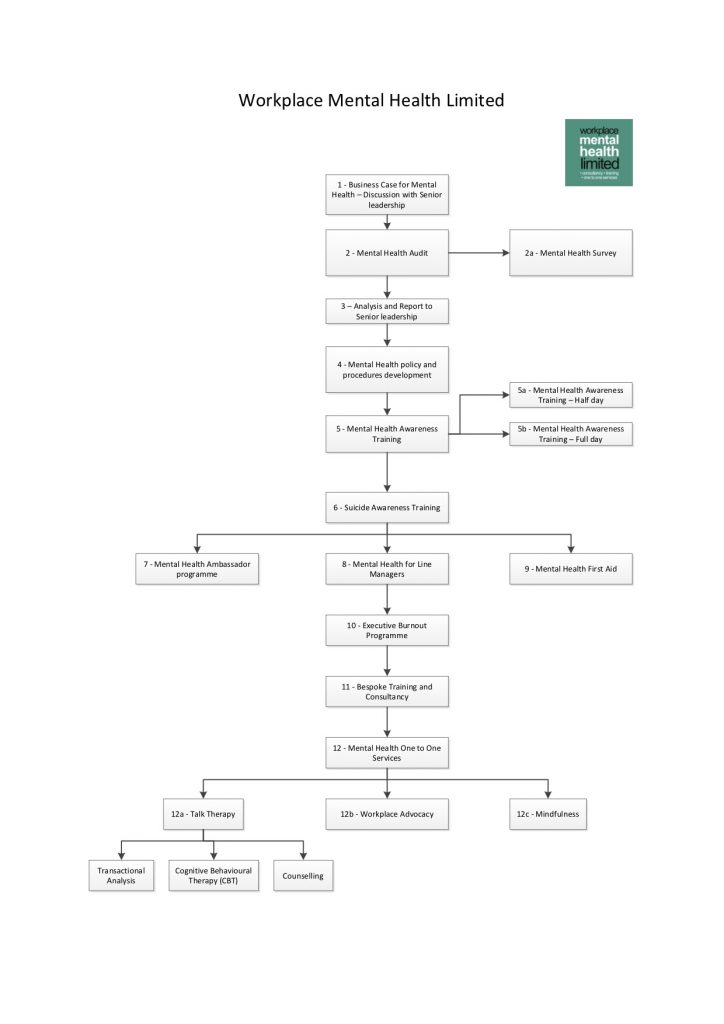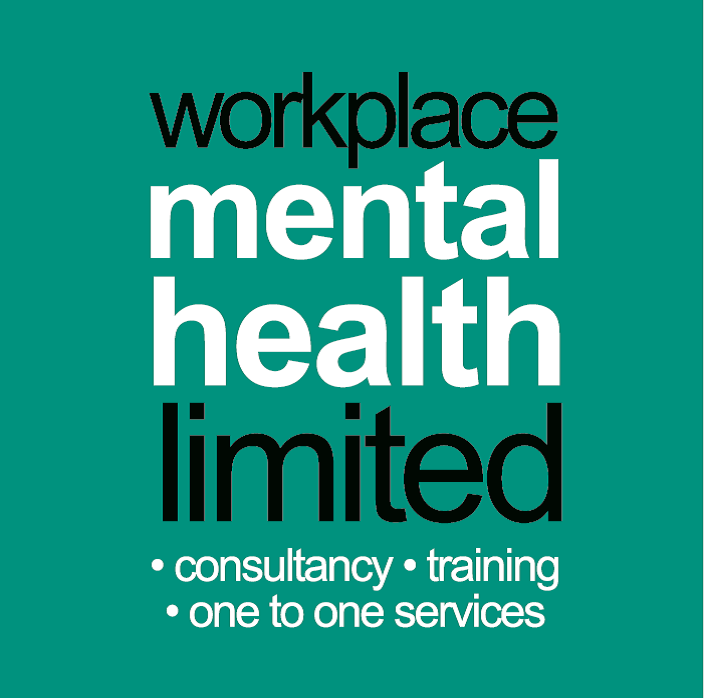
We use a stepwise model to deliver our products and services.

| 1 | The business case for mental health in the workplace. We meet with the senior leadership team so that they understand how important this subject is. |
| 2 | We conduct an audit to establish the mental health risk of the organisation. This is handled using an online survey and a number of face to face interviews. If staff do not have internal email we can do this by interviews or focus groups. |
| 2a | We conduct a survey to establish the mental health risk of the organisation. This is handled using an online survey. There is no analysis provided as is the case with a Mental Health Audit, there are no face to face interviews conducted as with the Audit. |
| 3 | We report back to the senior leadership on the analysis of the audit in a Red Amber Green (RAG) format. This highlights the specific needs and requirements of each organisation. It also allows us to compare and benchmark. It also gives us a baseline so that progress can be measured later. We conduct a re-audit 12 to 18 months after the first to establish progress. |
| 4 | Mental Health policy and procedures development. Staff are often frustrated that the board are saying they have policy and procedures but these aren’t brought to life, staff have lack of confidence and faith in the organisations approach to mental health. This development shows commitment to mental health and wellbeing for the organisation and the staff. It lays out clearly what the organisation are going to do when it comes to mental health and wellbeing |
| 5 | Mental health awareness training for the whole staff. This is really important. Most people do not have any knowledge about mental health and need to know what is meant by ‘Mental Health’. We have discovered that most people immediately think schizophrenia or bi polar but that only accounts for 2% of the population. The remainder of the 25% who experience poor mental health are those that need explaining. This training falls into two levels, half a day and a full day. |
| 6 | Suicide awareness training. People are extremely anxious about how to approach suicide situations. This programme helps to dispel the myths about suicide, how to help and what to do for the best. Suicide is the biggest killer of all people under the age of 35. |
Depending upon the requirements identified by the audit a combination of the following will be actioned.
| 7 | Mental Health – Ambassador programme. Delegates to this programme will have already completed an introduction to mental health awareness. They will be keen to help organisations design, plan and implement workplace mental health programmes. |
| 8 | Mental Health – For Line managers. For line managers, understanding your employees their challenges and their mental health helps you to be a better line manager, be better at your job and grow your career path within your organisation. We provide practical solutions that you as a line manager can do to support the staff that work for you. Creative ideas, putting problems in context to help your staff to continue to be productive, enjoy their work and feel comfortable and supported in the workplace. Focusses on how you as a line manager can spot the issues and be able to sensitively do something about it from a line manager perspective. |
| 9 |
Mental Health – First Aid. Mental Health First Aid (MHFA) is an
internationally recognised training course which teaches people how to spot
the signs and symptoms of mental ill health and provide help on a first aid
basis. MHFA won’t teach you to be a therapist, but just like physical first aid, it will teach you to listen, reassure and respond, even in a crisis. Every MHFA course is delivered by a quality assured instructor who has attended our Instructor Training programme accredited by the Royal Society for Public Health, and is trained to keep people safe and supported while they learn. |
| 10 | Executive burnout. Like generalized stress, burnout cuts across executive and managerial levels. While the phenomenon manifests itself in varying ways and to different degrees in different people. It is a phenomenon that occurs after people expend a great deal of effort, intense to the point of exhaustion, without visible results. People in these situations feel angry, helpless, trapped, and depleted: they are burned out. This experience is more intense than what is ordinarily referred to as stress. The major defining characteristic of burnout is that people can’t or won’t do again what they have been doing. We have tools and methods to help prevent and mitigate burnout in executives on a 1 to 1 intensive and private basis. |
| 11 | Bespoke training support and consultancy. As a professional Mental Health organisation with the support of a long established mental health charity Workplace Mental Health is ideally positioned to develop and implement the most effective programmes of support, training and consultancy that you want. |
| 12 | Services – Talking therapies, Advocacy, Mindfulness. Sometimes people like us to provide services such as counselling, CBT, transactional analysis and other to help with psychological problems. We also help employees with the more practical aspects of life with an advocacy service. We can also help with wellbeing activities such as mindfulness. |

